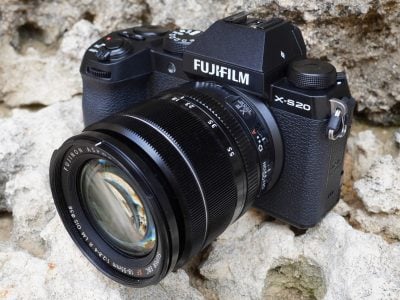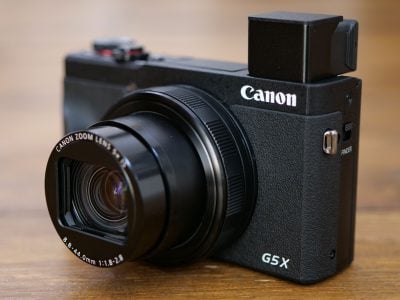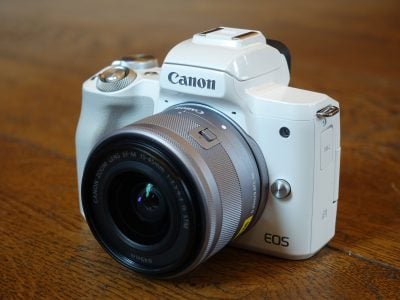Olympus E-500 / EVOLT E-500 review with Zuiko Digital 14-45mm f3.5~5.6
-
-
Written by Gordon Laing
Olympus E-500 lens
The most common lens bundled with the Olympus E-500 is the Zuiko Digital 14-45mm f3.5~5.6. This delivers a 3x optical range equivalent to 28-90mm on a 35mm or full-frame body. It is our policy to test budget digital SLRs with these bundled lens options, as they are normally the ones many owners end up using the most, or at least initially. As such, the optical results on the next page and the gallery examples on the one after are all taken with this lens.
We have additionally tested the E-500 with several other Zuiko Digital lenses; our full review of the one of the most impressive models, the Zuiko Digital 7-14mm ultra-wide angle, can be found here. In the meantime, the coverage offered by the 14-45mm lens can be seen in the examples below.
Composition and screen
Like traditional Digital SLRs, composition with the E-500 is performed using its optical viewfinder alone. The shooting information is shown on a vertical strip to the right of the focusing screen and includes aperture, shutter speed, exposure compensation, metering and shooting mode.
The view through any Digital SLR with a cropped sensor can appear quite small compared to a full-frame digital or 35mm film camera, but the E-500’s appears even smaller still. It may deliver the typical 95% field of view, but thanks to the squarer 4:3 aspect ratio of its sensor, the view appears narrower than other Digital SLRs. It really is like peering through a tunnel, although after a while you get used to it.
Compensating for the tiny viewfinder is a generous 2.5in colour screen sporting 215K pixels. Since this occupies a large portion of the rear of the camera and there’s no room on the top surface, this main screen doubles-up for showing shooting information – just like the Konica Minolta 5D.
 |
Like the KM 5D, you can also cycle between two different formatting options, by pressing the Info button. The more detailed of the two shows an absolute wealth of information including the image pixel dimensions, colour space, sharpness, contrast and saturation settings. By pressing the OK button you can also move around this page using the four buttons and select the option you’d like to change without having to delve into menus.
 |
This selection process works well in practice, although it’s annoying to find the screen still illuminated as you move your eye to the viewfinder to take a picture. This can be quite distracting, but rather than sensibly fit an proximity sensor like Konica Minolta, you’ll need to manually turn the E-500’s screen off by pressing the info button again. Unlike the Konica Minolta D-SLRs, the information on the screen also doesn’t rotate as you turn the camera body. This and the eye proximity sensor are small points, but illustrate the 5D’s classiness.
 |
What the E-500 lacks in this respect though it makes up for in detail and options. During playback the Info button allows you to cycle through no fewer than seven pages of information including brightness or RGB histograms and separate flashing Highlight and Shadow warnings. It’s impressive to have this level of information available, especially on a budget model.
 |
The E-500 allows you to zoom-in up to 14 times on images during playback, although unfortunately there doesn’t appear to be any detail beyond the 8x position. Don’t worry, there really is additional detail on images recorded at the full resolution, but annoyingly you can’t see it all when zooming-in during playback. This is a disappointment for anyone who likes zooming-in to the maximum detail available, perhaps to confirm the focus.
 |
The menus are based around five main sections, dealing with shooting, playback and setup. They’re familiar to anyone who’s used an Olympus digital camera before and again, like the Info button, allow you to change an unusually wide variety of options for a camera of this price. For example like earlier Olympus cameras you can configure the compression settings with much finer control than most rivals, and there’s also a number of bracketing options including White Balance, AE, Flash and Manual Focus.
 |
Yes, you read that right: manual focusing bracketing on an SLR. Like the E-300 before it, the E-500 employs a motorised system for focusing in both auto and manual focus modes. There’s even a menu option which allows you to choose whether the focusing ring operates clockwise or anti-clockwise – see left.
This can be quite eerie for the lenses with focusing distances marked behind a small window though – imagine turning the focusing ring one way and seeing the markings turn the other. Interestingly the lens focus also resets itself to infinity when you power the camera down.
 |
It’s important to state this focus-by-wire system is a world apart from the motorised manual focusing options on a compact or all-in-one bridge camera, and the increments really are impressively fine. But they remain finite increments none-the-less, and to us just don’t feel as reactive or precise as the mechanical manual focusing on a traditional SLR. If you’re into manual focusing, you’ll really have to try the E-500 for yourself to see if this is an issue or not. On the upside, the auto focus performance is certainly very good.
Sensor and files
The E-500 is equipped with an 8 Megapixel CCD sensor which measures 17.3x13mm and conforms to the FourThirds format – this means any lenses you attach have their field of view reduced by two times, so the optionally bundled 14-45mm zoom would effectively perform like a 28-90mm lens on a 35mm or full-frame body. The FourThirds mount will take any FourThirds compatible lens such as the increasing range of Zuiko Digital models – 15 at the time of writing.
Images have a 4:3 aspect ratio and the maximum size measures 3264 x 2448 pixels. There are also six lower resolutions available, and any can be saved as a JPEG with the choice of four different compression levels from 1 / 2.7 to 1/12; the 1 / 2.7 setting is very mild and ideal for eliminating almost all compression artefacts. Highest resolution JPEGs recorded using this setting work out around 5MB each.
For better quality still, the top resolution can alternatively be recorded in either uncompressed TIFF or 12-bit RAW formats; RAW files can be recorded with an accompanying JPEG if desired. The supplied Olympus Master software can be used to process RAW files and also allows updating of the camera firmware through your computer.
Colour and white balance
 |
The E-500 offers eight different white balance settings from 3000 to 7500K, along with white balance compensation and bracketing – both impressive features for a budget Digital SLR. Adobe RGB and sRGB colour spaces are supported and there’s five picture modes to choose from: Vivid, Natural, Muted, Black and White and Sepia; we used the Natural setting for our Results and Gallery shots over the following two pages.
 |
Depending on the picture mode, you can vary saturation, contrast and sharpness by up to five different levels, while Black and White mode allows you to choose from four coloured filter simulations and four toning options. Again this is an impressive level of control, especially for a budget digital SLR.
Additional features
 |
One of the E-500’s biggest selling points – and that of the entire E-system – is undoubtedly Olympus’ unique SuperSonic Wave Filter, SSWF. This vibrates the filter in front of the sensor every time the camera is powered-on to literally shake any particles from its surface. Olympus seems to be the only manufacturer actively combating this problem to date and is to be commended for doing so.
It’s not all good news though. As the camera powers-up the screen shows a short animation to advertise the SSWF in action (see left), but the entire process takes about 2.7 seconds to complete. It’s possible to reduce this time by about a second by disabling the animation, but it’s still a slow startup compared to the 0.2 seconds of most Digital SLRs these days.
 |
The timing of the SSWF process also seems a little odd. Surely it would be more appropriate to only activate the system when a lens is removed or swapped as oppose to every time the camera is switched on. Even if there was dust on the sensor, it would have been good to have the option to disable SSWF entirely on startup for times when you needed the quickest response – always assuming that the delay is entirely down to the anti-dust process of course.
That all said, we greatly appreciate the efforts of Olympus to eliminate the worries of dust, and having swapped lenses many times during the test period and checked the images closely, we could see no evidence of foreign particles on them.
Continuous shooting
The E-500 claims a continuous shooting capability of 2.5 fps. Equipped with a Sandisk Ultra II 1GB Compact Flash card and set to the highest resolution and mildest compression (1/2.7), we captured five frames in just over two seconds – this equates to around the quoted 2.5fps.
After shooting five frames with these settings, the camera paused for four and a half seconds to clear its buffer and record them to the card. Interestingly if you’d kept the shutter release button pressed after this burst, the camera won’t continue to take frames once the buffer had cleared. Instead you’ll need to let go of the shutter release and press it again for another burst. If you shoot with higher compression, you may achieve longer bursts.


14-45mm at 14mm, f8 (28mm equivalent)
14-45mm at 45mm, f8 (90mm equivalent)




